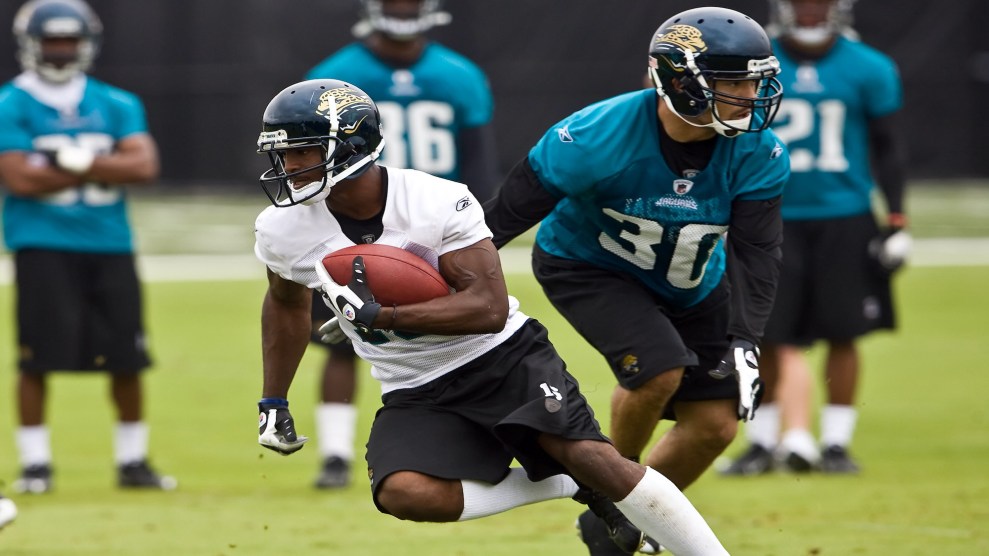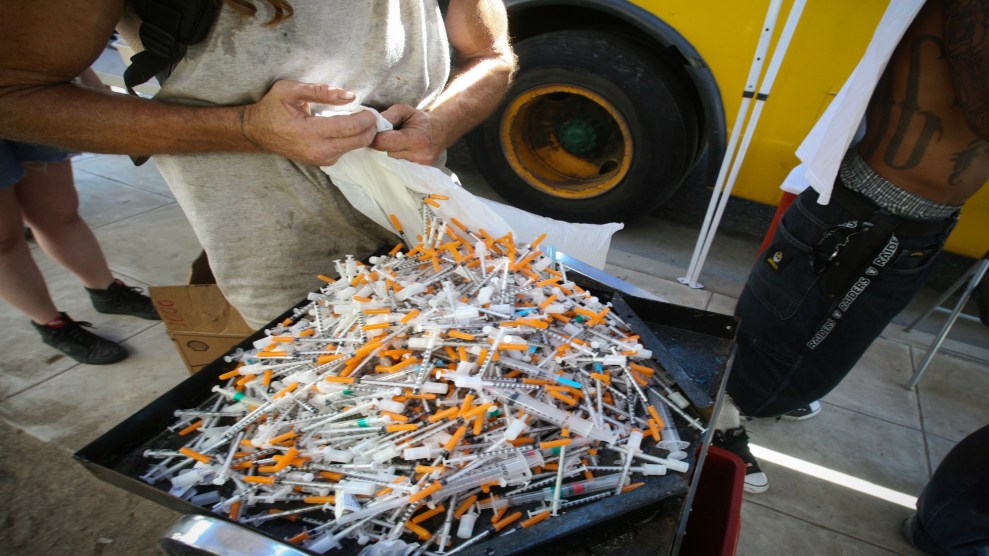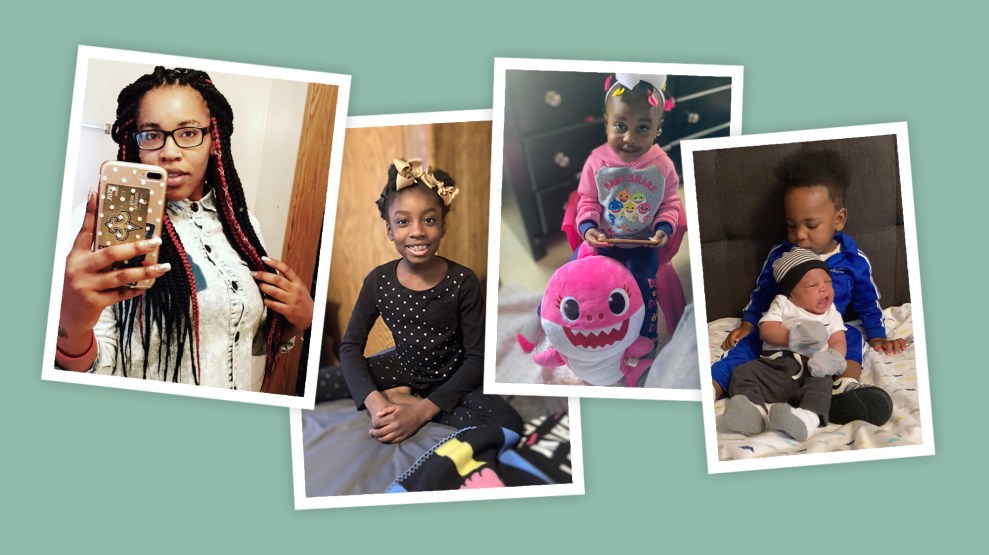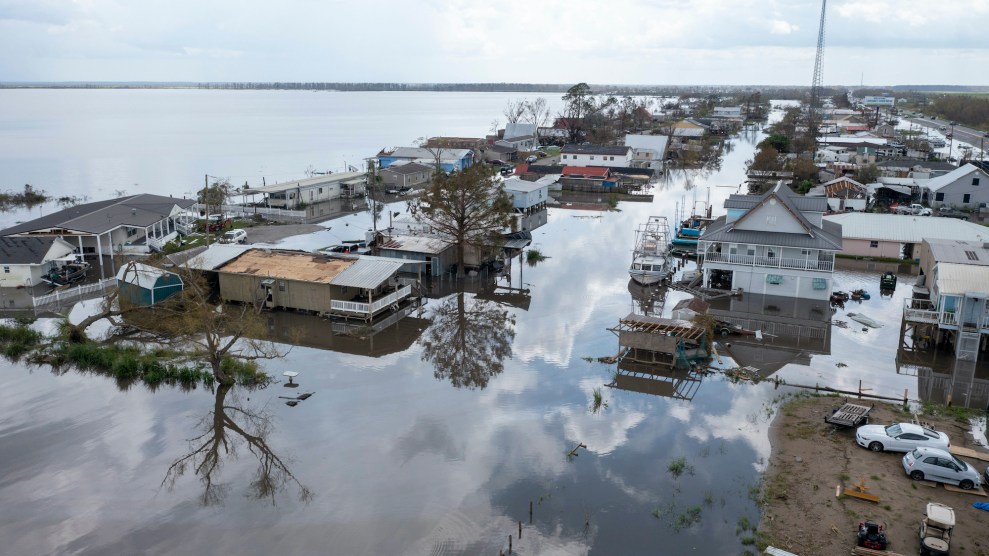
Former NFL player Nate Hughes, shown here in 2009, recently became a physician.Gray Quetti/Cal Sport/ZUMA
This story was originally published by Undark and is reproduced here as part of the Climate Desk collaboration.
Aaron Bolds didn’t consider becoming a physician until he tore a ligament in his knee while playing in a basketball tournament when he was 15. His orthopedic surgeon was Black, and they hit it off. “He was asking me how my grades were, and I told him, ‘I’m a straight-A student,’ and he was, like, ‘Man, this is a great fallback plan if basketball doesn’t work out,’” recalls Bolds, who is African American.
“He looked like me,” Bolds says, “and that was even more encouraging.”
If not for that chance encounter, Bolds, 34, a doctor at Mount Sinai Health System in New York, might never have gone into medicine, he says. When he was growing up, there were no physicians in his family or extended social network to model that career path. And at the schools he attended, he says, his aptitude for science didn’t trigger the kind of guidance young people often receive in more privileged contexts.
What Bolds did get attention for was his athletic ability. He got a full basketball scholarship to Lenoir-Rhyne University in North Carolina, where his team won a conference championship. But when he transferred to Bowie State University in Maryland, where he also played basketball, an academic adviser discouraged his pre-med ambitions, Bolds recalls, saying his grades were low and he lacked research experience.
Bolds is not alone in finding in athletics a fraught lever of educational opportunity. Whereas Black players comprise more than half the football and basketball teams at the 65 universities in the top five athletic conferences, and bring in millions of dollars for their schools year after year, the graduation rates for Black male college athletes are significantly lower—55 percent as compared to 69 percent for college athletes overall—according to a 2018 report from the USC Race and Equity Center. Many Black college athletes end up without either a professional sports contract or a clear career path.
Now some educators and advocates are looking to reverse this trend by connecting sports, an area in which African American men are overrepresented, and medicine, where the opposite is true. As of 2018, 13 percent of the U.S. population, but just 5 percent of doctors—according to the Association of American Medical Colleges—identified as Black or African American. (The AAMC data notes that an additional 1 percent of doctors identified as multiracial.) Decades of efforts to increase diversity at medical schools have made progress with other demographics, including Black women—but barely any with Black men. “No other demographic group is broken down with such a large split between men and women,” says Jo Wiederhorn, president and CEO of the Associated Medical Schools of New York. “And none of them have stayed stagnant, like that group has.”
According to data the AAMC provided to Undark, the proportion of Black men enrolling in medical school hasn’t changed much since 1978—with only some headway being made in the past few years.
The absence of Black male medical professionals ripples across the health system, experts say, contributing to widespread health disparities. African Americans tend to be diagnosed later than White people with everything from cancer to kidney disease, leading to more advanced disease and earlier deaths. Meanwhile, a recent study suggests that Black men who see Black male doctors may be more likely to follow medical advice. Other research also suggests that racially concordant care, in which patients and doctors have a shared identity, is associated with better communication and a greater likelihood to use health services.
“We are in a crisis point, nationally,” says Reginald Miller, the dean for research operations and infrastructure at Icahn School of Medicine at Mount Sinai. “I don’t think it’s a stretch to suggest that the health of communities of color are directly proportional to the number of practitioners available to see,” he says. “It’s just that straightforward.”
Last year, the National Medical Association, a professional organization representing African American physicians, embarked with the AAMC on a joint effort to address the structural barriers to advancement for Black men. “We need to look at this with a unique lens,” says Norma Poll-Hunter, senior director of workforce diversity at the AAMC.
There is no single solution to such an entrenched and multifaceted problem, Poll-Hunter says. According to her, some medical schools have adopted a holistic admissions process that evaluates many personal factors rather than relying on standardized test scores, which can exclude promising Black candidates. In addition, she says, students of color need better access to high-quality K-12 science education, particularly in under-resourced public schools. “There are a lot of barriers that exist early on,” she notes, “and that then creates this narrowing of the pathway to medicine.”
But the novel strategy of wooing athletes is slowly gaining traction. Advocates point out that high-performing athletes possess many of the skills and attributes that doctors, psychologists, physical therapists, and other medical professionals need—things like focus, a commitment to excellence, time management, and problem-solving skills, as well as the ability to take constructive criticism and perform under pressure.
“When you say, ‘What’s your ideal medical student?’ it’s not just a kid who’s academically gifted. It’s a kid who’s got resilience, attention to detail, knows how to work on the team,” Miller says. “Because science and medicine are team sports.” And by virtue of being athletes, these young men are already attuned to nutrition, fitness, and other aspects of human biology.
Two former NFL players, Nate Hughes and Myron Rolle, recently became physicians. And there is evidence that competitive sports experience contributes to medical success. A 2012 study of doctors training to become ear, nose, and throat specialists at Washington University, for example, found that having excelled in a team sport was more predictive of how faculty rated their quality as a clinician than strong letters of recommendation or having attended a highly-ranked medical school. Likewise, a 2011 study found that having an elite skill, such as high-achieving athletics, was more predictive of completing a general surgery residency than medical school grades.
Advocates of the athletics-to-medicine pipeline point out its practicality. Thousands of Black men are already in college, or headed there, on athletic scholarships. It would only take a small percentage of them choosing medical careers to boost the percentage of Black male doctors to better reflect the proportion of African American men in the general population, they say.
No one thinks it will be easy. One obstacle, advocates say, is a lack of role models. Black sports celebrities are household names, but some young athletes may never encounter a Black medical professional. “People don’t believe they can become what they don’t see,” says Mark R. Brown, the athletic director at Pace University.
And for the best chance of success, many say, these young men need to form and pursue medical aspirations as young as possible, along with their athletic training. “Those kids who are able to do both, the rewards at the end are enormous,” Miller says. But the adults in their lives may not believe the dual path is possible. “The second that a kid says to a science teacher or someone else that he’s an athlete,” Miller says, “they go into a different category. ‘They’re not really serious about science and medicine, they’re just here, and so I don’t expect this kid to really achieve.’”
Rigid course and practice schedules also make it challenging for busy athletes to undertake demanding and time-intensive science majors, observers say. What’s needed is “a cultural change, and not just a cultural change with the athletes. It’s a cultural change with the whole structure,” Miller says. “Everybody’s excited about the idea” of the physician athlete, he adds, “because it makes sense. But when the rubber hits the road, it is challenging.”
Donovan Roy, the assistant dean for diversity and inclusiveness at Homer Stryker M.D. School of Medicine at Western Michigan University, was one of the first people to envision the potential of directing Black athletes toward medical careers.
Roy, 48, who is Black and a former college football player, grew up in the working class, primarily Black and Latino community of Inglewood, California. Attending an elite private high school on a football scholarship was eye-opening. He vividly remembers the first time he ever saw a walk-in pantry, at a friend’s home. “It was stocked like a convenience store,” he recalls. “Five different types of Hostess, Ding-Dongs, sodas, every type of snack that you ever wanted.” Equally startling was speaking with another friend’s mother, who was a lawyer. “I’d never seen a road map to success in my community,” he says.
Roy’s athletic talent continued to open doors—at 18 he got a scholarship to the University of Southern California—but poorly prepared by the under-resourced public schools he had attended through ninth grade, he struggled academically, and left both USC and later another university that he also attended on an athletic scholarship.
Eventually Roy found his footing, and when he did, he became a learning specialist. After working through his own academic struggles, he wanted to help others with theirs. Roy took a job as a learning skills counselor at UCLA’s medical school. There he helped the students who were struggling with classes like anatomy and genetics. In early 2015, he returned to USC as the director of academic support services at Keck School of Medicine.
Something Roy noticed at both these medical schools stuck with him, though it would take a few years for the observation to crystallize. A certain kind of student sought help despite, by ordinary standards, not needing it. These were the athletes, and many of them were Black or Latino. “They always talked about, ‘How can I excel? How can I get better?’” he recalls. They “were getting 90s and they wanted to be 100.”
Roy began a doctoral program in education in 2015, the same year the AAMC published a damning report about the lack of Black men entering medical school. This was a crisis Roy understood both personally and professionally. For his dissertation, he decided to interview 16 Black male students at Keck School of Medicine. What was it about them, he wanted to understand, that had gotten them there against all odds?
The answer, he discovered, was what academics call social capital. For medical students from privileged backgrounds, social capital might take the form of a family friend who arranges a summer internship at a biotechnology lab, or a well-funded high school that offers advanced placement science classes. The young men Roy interviewed did not, for the most part, have access to those sorts of resources.
“Growing up, I didn’t see a Black male with a college degree until I got to college,” medical student Jai Kemp said in a separate interview Roy conducted for a documentary he’s making on the topic. The social capital these young men leveraged to get to medical school took the form of parental support, science enrichment programs and clubs, peer social networks, faculty mentors—and the perks that come with athletics. “For me it was just sports that got me through,” Kemp said.
The pieces started to fit together. Roy knew from his own experience all the benefits athletes get, not just entrée to educational institutions, but travel, enrichment, and academic advantages like tutoring and early class registration. Athletes also tend to possess social cachet on campus and, with more exposure to different types of people, may feel comfortable in environments that seem foreign and forbidding to other young people from disadvantaged backgrounds. Roy also recalled the drive for academic excellence he had observed in the athletes who came to his tutoring programs. “I got this epiphany,” he says. “Why don’t we look at student athletes in order to increase Black males’ representation in medicine, because they have the most social capital and the most network on predominantly White campuses.”
But when Roy began talking to his medical school colleagues about recruiting athletes, who according to a report from the Center for American Progress—a liberal think tank—make up 16 percent of Black male college students receiving athletic aid in the Big 12 athletic conference, he says most weren’t receptive to the idea. The same thing happened when he got up the nerve to make the suggestion publicly at a 2018 conference in Orlando, Florida. The idea ran against type. “I think people tend to lump athletes into this box,” he says. “They just think that athletes are big meatheads.”
Roy knew this truth viscerally, because with his offensive lineman’s build of 6-feet-6-inches and 300-plus pounds, he sticks out in academic settings. “People stare,” he says. “They do not expect me to be in the role that I am in.”
What Roy didn’t know was that the idea was percolating elsewhere, including at the National Collegiate Athletic Association. Brian Hainline, the NCAA’s chief medical officer, says he and Poll-Hunter of the AAMC are in talks with several universities about launching a pilot program to support African American athletes interested in medical careers.
Meanwhile, in 2018 Miller founded the organization Scholar-Athletes with Academic Goals (a.k.a. SWAG, a name he hopes will resonate with young people). The initiative connects promising athletes with a range of available programs to help them pursue and succeed in science and medicine. Recently, Miller worked closely with leadership at Pace University to create a program, expected to launch next year, to support Black college athletes interested in attending medical school. Pace officials want the initiative to become a magnet for out-of-state athletes and a model for other schools. “My hope is that two years from now, colleges and universities will call” and ask, “Wow, how did you do this?” says athletic director Brown. “Once we have some success, and proof of concept, then I think it can really grow.”
Bolds graduated medical school in 2018 and is now doing his residency at Mount Sinai. His focus is rehabilitation medicine, and he plans to tend to injured athletes and serve as a team physician. He got a business degree while in medical school, and his long-term goal is to open his own interventional spine and sports medicine practice specializing in preventing and rehabilitating injuries in both athletes and non-athletes, as well as helping serious players enhance their performance.
But there were tough moments along the way, such as the encounter with that academic adviser, which Bolds says only served to motivate him. At the time, he thought, “Wow, this person doesn’t believe in me. So let me make them a believer,” he recalls. “That was, moving forward, really a turning point for me, honestly. Because I knew that people aren’t going to believe in you unless you give them a reason to.”
Bolds began to apply an athletic mindset to his pre-med classes. “That same grind of having to get up, 5 a.m., get to the gym, get shots up before anybody gets there, to put in that extra time—I was doing that with my studies,” he says. “I would get to the library before anybody.” Once Bolds turned his grades around, professors began to notice and help him, he says. Still, he says, his score on the MCAT, an entrance exam required by nearly all U.S. medical schools, was borderline. Instead of giving up, he attended multiple events at Howard University’s medical school, where he met people who advocated for him. It was the only medical school he got into.
Whereas Bolds had to bushwhack, he saw other Black students fall off the medical path—and his fellow Black teammates avoided it entirely. Many athletes find themselves enmeshed in a profit-making system that may not prioritize their education. The NCAA has been criticized in recent years for its long-standing policy which prohibits profit-sharing with college athletes—a policy that was only recently reversed under interim guidelines. Others have said that Black labor has been especially exploited.
As of 2014 reports, fewer than 2 percent of athletes in the NCAA will go on to play professionally. But for self-serving reasons, critics say, (Clemson University’s football team, for example, made $77 million in average annual revenue from 2015 through 2017) universities often direct athletes to “academic paths of least resistance.” Many schools practice “major clustering,” in which players are steered to the same relatively undemanding major, such as communications, so they can devote themselves almost entirely to their sport. Major clustering is more pronounced among athletes of color, according to a 2009 study of football teams at 11 universities. At six of those schools, the study found, over three-quarters of the non-White football players were enrolled in just two academic majors, although dozens of majors were offered.
Sheron Mark, an associate professor of science education at the University of Louisville, co-authored a 2019 case study of two young Black men who arrived at college on basketball scholarships, with the intent to pursue respective careers in computer science and engineering. But both found it difficult to balance academics with athletics because of pressure and blandishments from coaches and faculty advisers.
“For so long, they’ve been sold this message that you don’t have many choices, that banking on a professional sports career is one of very few options for you if you want to advance your station in life,” says Mark of many Black athletes. It’s important to have a plan B, she says, since “the odds just aren’t in their favor.” But coaches can discourage academically demanding majors because they may cut into practice time, and college athletes are not always capable of pushing back, she says, because their financial packages are tied to fulfillment of their team responsibilities.
Many Black college athletes are already strong candidates for medical school, advocates say, but others may need extra academic support to compensate for deficits acquired at under-resourced K-12 schools. They may also need post-graduation training to take science classes they did not have time for while working long hours as athletes—with some working 20-plus hours a week. “How are they being mentored and guided and protected in planning for their futures?” Mark asks. “They are high achieving in sports, they want to be high achieving in academics. Why don’t we support them?” When people wonder whether student-athletes can cut it in science and medicine, Mark’s response is: “It’s on us. It’s on us to help them do so. That’s how we can grow their representation.”
That’s what Pace University intends to do. The school already nurtures academic success in its athletes, who collectively had a B+ average last school year, but premedical studies have never been a great fit, in part because afternoon practices can conflict with long lab classes, says athletic director Brown. As part of the school’s new initiative, Pace science departments have pledged to offer flexibility in course section offerings in order to accommodate football commitments. Athletes of color from any sport will be welcome, but football was prioritized because it is the largest and one of the most diverse teams and has the most complicated schedule, Brown says.
The school also plans to adjust its advising, tutoring, and library services to ensure that pre-med athletes won’t falter when they struggle with personal issues or tough classes like organic chemistry. “Rather than saying, ‘Oh, chemistry, nobody likes chemistry, you’re right, you should just drop that,’ instead now it’s going to be, ‘Yeah, you’ve got to buckle down. And here’s how we’re going to do it,’” says Hillary Knepper, the university’s associate provost for student success.
Meanwhile, Brown will be directing his coaches to actively recruit Black and Latino high school athletes who are interested in medicine. In the past, Brown says, his coaches were less likely to select such students because of anticipated scheduling challenges. But now Pace is trying to establish a partnership through which a nearby medical school would give preferred consideration to pre-med athletes who have completed the Pace curriculum. “With our new approach, you’re not only going to have the ability to do it,” he says, “but you’re going to have a support system, to make sure that you follow the path.”
Some advocates for the athlete-to-doctor paradigm see this work as part of the larger movement for social justice. “Look what Jackie Robinson did, right? Look at Muhammad Ali, look at Colin Kaepernick,” Roy says. “Athletics has always been the vehicle for social change.”
Medical professionals can influence public policy, accumulate wealth, and help empower others in their orbit. “The impacts ramp up really quickly, from just that individual benefiting,” Mark says, to “your family, your neighborhood, your social network, and society—people you won’t even meet, and across generations.”
Studies suggest that African American doctors are more likely to choose to work in underserved communities. They also may be more attuned to, and motivated to combat, the disparities in health care. A study published last year, for example, suggests that Black newborns are half as likely to die when they are cared for by a Black physician.
Bolds is keenly aware of the health disparities for Black communities, and he jumps at opportunities to mentor other young Black men, to show them that they, too, can become doctors. “It seems like there’s so many steps that just are never-ending,” he says. But, he adds, to see someone “that you can connect with that’s at that finish line or has already passed that finish line—I think that’s very key to their success.”
One of the people Bolds has connected with is Darius Ervin, a talented Black basketball player from Crown Heights, Brooklyn, who is now a sophomore at Cornell University. The two met when Ervin attended a virtual event late last year, sponsored by SWAG, at which Bolds spoke. Afterwards, the two chatted, and Bolds now checks in periodically with Ervin, who says he appreciates the encouragement. “Those are people that have once laced up shoes and got on the court and played just like how I did, and now they’re in the hospital helping people,” he says. “Being able to speak to those people gives me the visual, allows me to see that it’s an opportunity and it’s definitely possible for me to do.”















